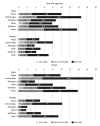Use of electronic cigarettes and hookah in Brazil: a new and emerging landscape. The Covitel study, 2022
- PMID: 36753212
- PMCID: PMC9970375
- DOI: 10.36416/1806-3756/e20220290
Use of electronic cigarettes and hookah in Brazil: a new and emerging landscape. The Covitel study, 2022
Abstract
Objective: To estimate the prevalence of current commercial cigarette smoking, as well as those of e-cigarette and hookah experimentation and current use among adults (≥ 18 years of age) in Brazil.
Methods: This study was based on a countrywide cross-sectional telephone-based survey conducted in 2022. The sample was designed to be representative of the five macroregions in Brazil and included 1,800 individuals from each of the regions. Telephone numbers, using a random digit dialing procedure, were proportionally selected for each direct distance dialing code in each region and then electronically validated (i.e., 900 cell and 900 landline phone numbers per region). Information on current commercial cigarette smoking (regardless of frequency/amount), as well as lifetime history of or current e-cigarette and hookah use (regardless of amount), were collected.
Results: The prevalence of lifetime history of e-cigarette and hookah use was identical (7.3%; 95% CI: 6.0-8.9), whereas the prevalence of current commercial cigarette smoking was 12.2% (95% CI: 10.4-14.1). Young adults (18-24 years) had the highest prevalence of e-cigarette experimentation (19.7%; 95% CI: 15.1-17.0) and hookah experimentation (17%; 95% CI: 12.2-23.2). E-cigarette and hookah use was more common in the Central-West region and among those with a high level of education, whereas current commercial cigarette smoking was more common among those with a lower level of education. Individuals who used the three forms of nicotine delivery corresponded to 1.5% of the sample (nearly 2 million individuals based on the estimated size of the Brazilian adult population).
Conclusions: Surveillance is essential for the monitoring and prevention of these new forms of nicotine consumption.
Objetivo:: Estimar a prevalência do consumo atual de cigarros industrializados, bem como da experimentação e uso atual de cigarro eletrônico e narguilé entre adultos (≥ 18 anos) no Brasil.
Métodos:: Este estudo baseou-se em uma inquérito telefônico nacional realizada em 2022. A amostra foi projetada para ser representativa das cinco macrorregiões do Brasil e foi composta por 1.800 indivíduos de cada uma das regiões. Por meio de um procedimento de discagem aleatória, os números de telefone foram selecionados proporcionalmente para cada código de discagem direta à distância em cada região e, em seguida, validados eletronicamente (isto é, 900 telefones celulares e 900 telefones fixos por região). Foram coletadas informações sobre o consumo atual de cigarros industrializados (independentemente da frequência/quantidade), bem como sobre a história de uso ou uso atual de cigarro eletrônico e narguilé (independentemente da quantidade).
Resultados:: As prevalências de história de uso de cigarro eletrônico e narguilé foram idênticas (7,3%; IC95%: 6,0-8,9), ao passo que a prevalência de consumo atual de cigarros industrializados foi de 12,2% (IC95%: 10,4-14,1). Adultos jovens (18-24 anos) apresentaram as maiores prevalências de experimentação de cigarro eletrônico (19,7%; IC95%: 15,1-17,0) e de narguilé (17%; IC95%: 12,2-23,2). O uso de cigarro eletrônico e narguilé foi mais comum na região Centro-Oeste e entre aqueles com maior grau de escolaridade, ao passo que o consumo atual de cigarros industrializados foi mais comum entre aqueles com menor grau de escolaridade. Os indivíduos que usavam as três formas de liberação de nicotina corresponderam a 1,5% da amostra (quase 2 milhões de indivíduos com base na estimativa do tamanho da população adulta brasileira).
Conclusões:: A vigilância é essencial para o monitoramento e prevenção dessas novas formas de consumo de nicotina.
Conflict of interest statement
Figures



References
-
- World Health Organization (WHO) [homepage on the Internet] WHO reports progress in the fight against tobacco epidemic. Geneva: WHO; c2021. https://www.who.int/news/item/27-07-2021-who-reports-progress-in-the-fig...
-
- Hoek J, Gendall P, Eckert C, Louviere J, Ling P, Popova L. Analysis of on-pack messages for e-liquids a discrete choice study. Tob Control. 2022;31(4):534–542. - PubMed
Publication types
MeSH terms
Substances
LinkOut - more resources
Full Text Sources
Medical

